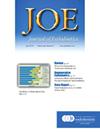牙髓管钙化的上颌恒牙根管治疗过程中动态导航操作的学习曲线:单个操作人员经验的风险调整累积求和(RA-CUSUM)分析。
IF 3.5
2区 医学
Q1 DENTISTRY, ORAL SURGERY & MEDICINE
引用次数: 0
摘要
动态导航系统(DNS)在牙髓学中呈现出明显的学习曲线。本横断面研究旨在评估在dns辅助治疗髓管钙化上颌前牙时达到一致效果所需的病例数。方法:对45颗牙髓坏死的钙化上颌前牙,由一名无临床牙髓缺损治疗经验的牙髓专家进行一系列牙髓缺损治疗。术前行锥形束计算机断层扫描(CBCT)。在轨迹匹配和校准后,使用低速钻头进行钻井。一旦根管被定位并探测到工作长度,立即进行术后CBCT。测量角度偏差(AD)、线性偏差(LD)和操作时间(OT)。采用风险调整累积和(CUSUM)分析法评估学习曲线。结果:根管定位总成功率为93.33% (95% CI 80.7, 98.3)。AD、LD和OT的平均(±SD)分别为3.21±2.23度、0.52±0.33 mm和34.14±13.18分钟。对于AD,在第5例和第18例观察到两个明显的高峰,确定了三个学习阶段:第一阶段(病例1-5),第二阶段(病例6-18)和第三阶段(病例19-45)。同样,LD在第13例和第28例出现高峰。第7例和第26例出现2个OT高峰。结论:使用DNS技术熟练定位钙化管大约需要18到28例,这表明必须克服重要的学习曲线才能达到最佳精度。本文章由计算机程序翻译,如有差异,请以英文原文为准。
Learning Curve for Dynamic Navigation Procedure during Endodontic Management of Permanent Maxillary Anterior Teeth with Pulp Canal Calcification: A Risk-Adjusted Cumulative Summation Analysis of a Single Operator's Experience
Introduction
The dynamic navigation system (DNS) in endodontics presents a significant learning curve. This cross-sectional study aimed to assess the number of cases required to achieve consistent performance in DNS-assisted treatment of maxillary anterior teeth with pulp canal calcification.
Methods
A series of DNS procedures were performed on 45 calcified maxillary anterior teeth with pulp necrosis by a single endodontist who had no prior clinical DNS experience. Preoperative cone-beam computed tomography was obtained. After trace registration and calibration, drilling was executed using a low-speed bur. Once the canal was located and scouted to the working length, a postoperative cone-beam computed tomography was taken immediately. Angular deviation (AD), linear deviation (LD), and operating time (OT) were measured. The learning curve was evaluated using the risk-adjusted cumulative sum analysis method.
Results
The overall success rate in locating canals was 93.33% (95% CI 80.7, 98.3). The mean (±SD) for AD, LD and OT was 3.21 ± 2.23°, 0.52 ± 0.33 mm and 34.14 ± 13.18 minutes, respectively. For AD, 2 distinct peaks were observed at the 5th and 18th cases, identifying 3 learning phases: Phase I (cases 1–5), Phase II (cases 6–18), and Phase III (cases 19–45). Similarly, LD exhibited peaks at the 13th and 28th cases. Two peaks for OT were identified at the 7th and 26th cases.
Conclusions
Achieving technical proficiency in locating calcified canals using DNS required approximately 18 to 28 cases, indicating a significant learning curve that must be overcome for optimal accuracy.
求助全文
通过发布文献求助,成功后即可免费获取论文全文。
去求助
来源期刊

Journal of endodontics
医学-牙科与口腔外科
CiteScore
8.80
自引率
9.50%
发文量
224
审稿时长
42 days
期刊介绍:
The Journal of Endodontics, the official journal of the American Association of Endodontists, publishes scientific articles, case reports and comparison studies evaluating materials and methods of pulp conservation and endodontic treatment. Endodontists and general dentists can learn about new concepts in root canal treatment and the latest advances in techniques and instrumentation in the one journal that helps them keep pace with rapid changes in this field.
 求助内容:
求助内容: 应助结果提醒方式:
应助结果提醒方式:


